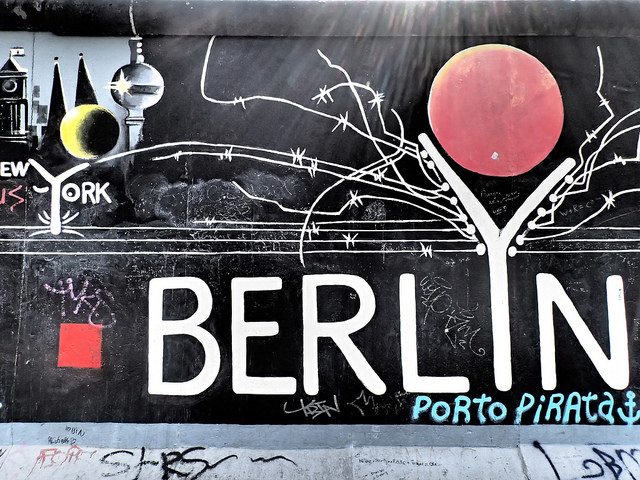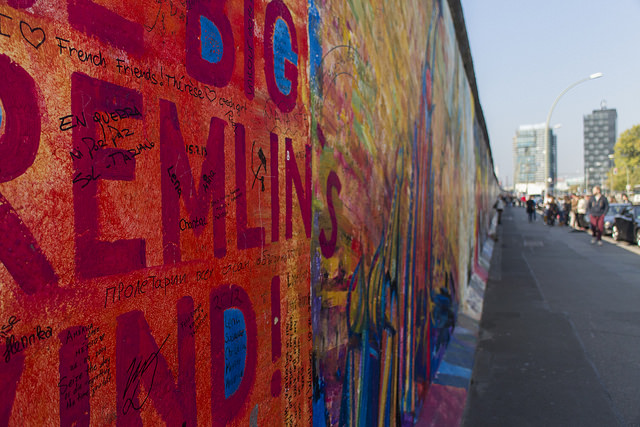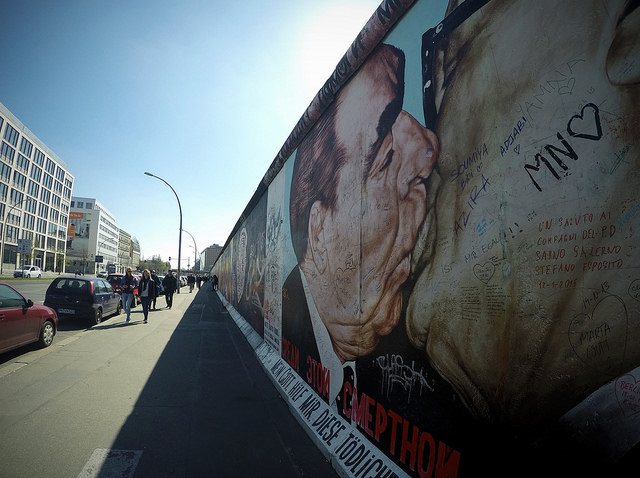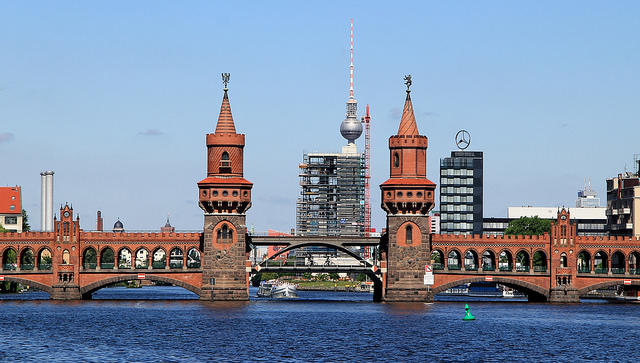Since the wall was knocked down in 1989, Berlin has blossomed into a completely different city. No longer separated into sections, it’s become the hipster capital of Europe, where creatives revel in the arty atmosphere and new-age travellers set up virtual offices. But despite it’s years of recovery, there are still reminders of Berlin’s grisly past.

Berlin connected up to other major cities, like New York (Photo: SarahTz via Flickr)
On one panel, black and white swirls pop with dashes of red, blues, and yellows, creating a hypnotic illusion that abruptly stops as the next panel begins. On this one, a red moon rises over the word Berlin, with connective lines reaching out to a smaller depiction of the New York skyline – an image that represents Berlin’s integration with the world’s most iconic cities.
On yet another panel, a vintage Trabi bursts through a turquoise wall, hand-scrawled sentences and commemorations plastered all over its bonnet, roof, and registration plate. Elsewhere, giant paintings of weirdly proportioned cartoons depict people crossing roads, kissing each other, and dancing against vibrant backdrops of intricate doodles and abstract patterns.
And these are only a few of the murals on display along the East Side Gallery.
Carving a crumbling path through the popular Friedrichschain-Kreuzberg district in Berlin, the wall acts as part gallery, part history museum, drawing visitors in with its colourful marks against an otherwise grey backdrop.

Scribbles cover most of the murals (Photo: Sam DeLong via Flickr)
Look beneath the pretty pictures, though, and it is easy to see a city that is still battling with its age-old demons. Yes, Berlin has spent a generation building its name as a trendy place for night revellers, and laidback creative types, but there are still remnants of a city in turmoil etched into the brickwork, and there is nowhere more evident of this than the East Side Gallery.
The bright colours pull passersby in, but it is the hidden messages, the stories, and the memories that keep them sticking around. Because the gallery is a collaborative effort between the people of the city. Though each panel has been commissioned by a certain artist to make their stamp on the wall, the locals and visitors have carved their own thoughts and feelings into the paintings to bring visitors a living, breathing vision of just how far Berlin has come.
Throughout the city I came across numerous sections of crumbling wall, but the East Side Gallery was by far the largest. Stretching out over 1.3km, it is one of Europe’s best-loved and biggest outdoor galleries.
It came to life back in 1990, when a collection of esteemed international artists came together to cover the wall in 101 paintings along the side facing away from the Spree. Some of these works of arts have become iconic images of Berlin’s gentrification, like Dmitri Vrubel’s eye-catching depiction of Brezhnex and Honecker kissing, and the colourful shutterbug faces of Thierry Noir’s cartoons.

Vrubel’s eye-catching mural (Photo: Bruno via Flickr)
Each panel seems to have been brought to life by the additional scrawlings of passersby. This, for me, was a nice touch, kind of like an interactive display where people were able to respond to and answer the messages imbued in each piece.
It seems a lot of others have the same views because, in 2009, the attempt to restore the wall to its non-graffiti glory was faced with controversy – not least from the artists who were rightfully livid that copies had been painted over their originals.
But even after the wall was restored, the people wouldn’t keep quiet. Today, every panel is etched with written memories, inspiring quotes, and the odd “woz ere’” tag, adding yet more stories to the already saturated wall.
It wasn’t just the artworks that made the East Side Gallery such a prominent part of my trip, though. The atmosphere around this part of the wall still remains achingly raw. While tourists stroll up and down the length of the gallery, stopping to snap selfies along the way, some of Berlin’s more dishevelled locals gather in the surrounding streets and under the cover of the Oberbaum Bridge.
Here, they crank out loud dance music and sit smoking in large groups. Some sleep on rucksacks, while others dance like they’re a million miles away from the brazen, bustling world of Berlin by day.
I walked across the Oberbaum Bridge on my way to the gallery, passing by these colourful characters, only to be met by more permanent ones plastered across the wall just metres away alongside a busy, five-lane road.

The Oberbaum Bridge, near the East Side Gallery (Photo: John Menard via Flickr)
It seemed strange seeing the artistic talents of such talented creatives exhibited alongside what is, essentially, a highway, but the raw appeal of the eclectic locals, the graffiti-covered murals, and the historic remnants managed to encompass Berlin’s 20-year growth in a single snapshot.
This is what made the East Side Gallery rocket to the top of my “city highlights”. Not the diverse selection of paintings, or the loving messages scratched into the paintwork, or the opportunity to see and touch a remainder of Berlin’s tragic past. It was the combination of it all together – something I’m sure wouldn’t have the same effect if it were displayed in a white cube gallery away from the city’s street life.
As I walked the length of the wall, I found myself scanning the handwritten comments – for some reason, these pulled me in the most. I wondered who had written them and what their story was. I wondered whether their lives had been changed once the wall came down, or whether the prospect of a brighter Berlin propelled them to leave their mark.
And when I’d done enough walking? I slipped through to the other side of the wall to grab a drink at a café on the banks of the Spree. The act of crossing the wall was an easy feat for me, but I had to remind myself that this was something a lot of people only dreamed of for a very long time. It was the moments of revelation like this that reminded me just how recent Berlin’s tragedies are, and just how far it has come in such a short space of time. I’m glad the East Side Gallery is there to celebrate, remember, and infuse a sense of humility over the city.